Hyphessobrycon
| Hyphessobrycon | ||||||||||||
|---|---|---|---|---|---|---|---|---|---|---|---|---|

Red phantom tetra ( Hyphessobrycon sweglesi ) |
||||||||||||
| Systematics | ||||||||||||
|
||||||||||||
| Scientific name | ||||||||||||
| Hyphessobrycon | ||||||||||||
| Durbin in Eigenmann , 1908 |
Hyphessobrycon is a genus of freshwater fish from the family of the true tetras (Characidae). The name Hyphessobrycon is made up of the words hyphesso "smaller" and brycon "biter", which alludes to the strong teeth of the tetra , which are assigned to this genus. The genus consists of over 140 species, but is not considered monophyletic . Hyphessobrycon species are usually quite small, socially living fish thatare native tonorthern and central South America. Very few species are also found in Central America .
features
Hyphessobrycon species have a more or less elongated body, in many species quite high back. The anal fin is long, an adipose fin is present. The sideline is incomplete. The genus differs from the closely related genus Hemigrammus in the dentition and the unscaled base of the caudal fin . Hyphessobrycon species become two to seven centimeters long.
Way of life
Hyphessobrycon species usually only show a tendency to form swarms when they are young or when there is concern or danger . Otherwise they live socially in groups with the aim of maintaining a minimum distance from one another. Males in particular are prone to commentary fights and sometimes defend small areas around preferred stands.
Systematics
The genus Hyphessobrycon is comparatively rich in species, especially since, in the course of newer classifications, some previously independent genera were merged with Hyphessobrycon . Since a revision of the Rosy Tetras by Stanley Weitzman & Lisa Palmer in 1997, the genus Hyphessobrycon also includes the species of the disbanded genus Megalamphodus . Since the type species of the genus, Hyphessobrycon compressus , comes from the catchment area of the Río Papaloapam in southern Mexico, the five Central American species and the species occurring in the Colombian Department del Chocó on the Pacific coast are considered Hyphessobrycon sensu stricto .


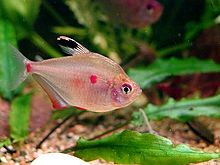

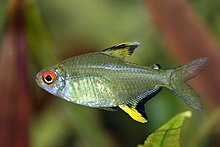
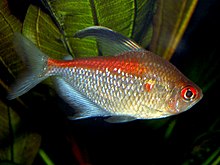
Hyphessobrycon panamensis species group ( Hyphessobrycon -sensu stricto)
- Hyphessobrycon bussingi Ota et al., 2020
- Red-blue Colombian ( Hyphessobrycon columbianus ) Zarske & Géry, 2002
- Hyphessobrycon condotensis Regan, 1913
- Hyphessobrycon daguae Eigenmann, 1922
- Hyphessobrycon panamensis Durbin in Eigenmann, 1908
- Hyphessobrycon savagei Bussing, 1967
Rosy tetra species group
- Hyphessobrycon axelrodi (Travassos, 1959) , may haveto be assigned tothe genus Pristella .
- Hyphessobrycon bentosi Durbin in Eigenmann, 1908
- Copeland's tetra ( Hyphessobrycon copelandi ) Durbin in Eigenmann, 1908
- Hyphessobrycon caru Guimarães et al., 2019
- Hyphessobrycon dorsalis Zarske, 2014
- Hyphessobrycon ecuadorensis (Eigenmann, 1915)
- Hyphessobrycon epicharis Weitzman & Palmer, 1997
- Blood tetra ( Hyphessobrycon eques ) (Steindachner, 1882)
- Cherry blotch tetra ( Hyphessobrycon erythrostigma ) (Fowler, 1943)
- Strawberry tetra ( Hyphessobrycon georgettae ) Géry, 1961
- Hyphessobrycon haraldschultzi Travassos, 1960
- Sichelsalmler ( Hyphessobrycon jackrobertsi ) Zarske, 2014
- Black phantom tetra ( Hyphessobrycon megalopterus ) (Eigenmann, 1915)
- Hyphessobrycon melasemeion Fowler, 1945
- Hyphessobrycon micropterus (Eigenmann, 1915)
- Minor tetra ( Hyphessobrycon minor ) Durbin, 1909
- Sonnensichelsalmler ( Hyphessobrycon paepkei ) Zarske, 2014
- Hyphessobrycon piorskii Guimarães, De Brito, Feitosa, Carvalho-Costa & Ottoni, 2018
- Lemon tetra ( Hyphessobrycon pulchripinnis ) Ahl, 1937
- Red-backed cherry spot tetra ( Hyphessobrycon pyrrhonotus ) Burgess, 1993
- Ornamental tetra ( Hyphessobrycon rosaceus ) Durbin, 1909
- Yellow phantom tetra ( Hyphessobrycon roseus ) (Géry, 1960)
- Hyphessobrycon simulatus (Géry, 1960)
- Socolofs cherry spot tetra ( Hyphessobrycon socolofi ) Weitzman, 1977
- Red phantom tetra ( Hyphessobrycon sweglesi ) (Géry, 1961)
- Hyphessobrycon takasei Géry, 1964
- Hyphessobrycon werneri Géry & Uj, 1987
Hyphessobrycon heterorhabdus or Hyphessobrycon agulha species group

- Hyphessobrycon acaciae García-Alzate, Román-Valencia & Prada-Pedreros, 2010
- Hyphessobrycon agulha Fowler, 1913
- Hyphessobrycon amapaensis Zarske & Géry, 1998
- Hyphessobrycon amaronensis García-Alzate, Román-Valencia & Taphorn, 2010
- Hyphessobrycon amapaensis Zarske & Géry, 1998
- Hyphessobrycon auca Almirón, Casciotta, Bechara & Ruiz Diaz, 2004
- Hyphessobrycon borealis Zarske, Le Bail & Géry, 2006
- Hyphessobrycon cachimbensis Travassos, 1964
- Hyphessobrycon chiribiquete García ‐ Alzate, Lima, Taphorn, Mojica, Urbano ‐ Bonilla & Teixeira, 2020
- Hyphessobrycon clavatus Zarske, 2015
- Hyphessobrycon coelestinus Myers in Eigenmann & Myers, 1929
- Lapis tetra ( Hyphessobrycon cyanotaenia ) Zarske & Géry, 2006
- Hyphessobrycon diancistrus Weitzman, 1977
- Hyphessobrycon ericae Moreira & Lima, 2017
- Hyphessobrycon eschwartzae García-Alzate, Román-Valencia, Ortega, 2013
- Hyphessobrycon fernandezi Fernández-Yépez, 1972
- Black neon ( Hyphessobrycon herbertaxelrodi ) Géry, 1961
- Three- banded tetra ( Hyphessobrycon heterorhabdus ) (Ulrey, 1894)
- Hyphessobrycon klausanni García-Alzate et al., 2017
- Loretosalmler ( Hyphessobrycon loretoensis ) Ladiges, 1938
- Hyphessobrycon lucenorum Ohara & Lima, 2015
- Hyphessobrycon margitae Zarske, 2016
- Hyphessobrycon mavro García-Alzate, Román-Valencia & Prada-Pedreros, 2010
- Hyphessobrycon melanostichos Carvalho & Bertaco, 2006
- Meta tetra ( Hyphessobrycon metae ) Eigenmann & Henn, 1914
- Hyphessobrycon montagi Lima, Coutinho & Wosiacki, 2014
- Hyphessobrycon mutabilis Costa & Géry, 1994
- Hyphessobrycon myrmex Pastana et al., 2017
- Hyphessobrycon niger García-Alzate, Román-Valencia & Prada-Pedreros, 2010
- Hyphessobrycon nigricinctus Zarske & Géry, 2004
- Hyphessobrycon notidanos Carvalho & Bertaco, 2006
- Hyphessobrycon oritoensis García-Alzate, Román-Valencia & Taphorn, 2008
- Hyphessobrycon paucilepis García-Alzate, Román-Valencia & Taphorn, 2008
- Hyphessobrycon peruvianus Ladiges, 1938
- Hyphessobrycon petricolus Ohara et al., 2017
- Hyphessobrycon piranga Camelier, Dagosta & Marinho, 2018
- Hyphessobrycon poecilioides Eigenmann, 1913
- Hyphessobrycon procerus Mahnert & Géry, 1987
- Hyphessobrycon psittacus Dagosta et al., 2016
- Black banded tetra ( Hyphessobrycon scholzei ) Ahl, 1937
- Hyphessobrycon sovichthys Schultz, 1944
- Stegemann's Tetra ( Hyphessobrycon stegemanni ) Géry, 1961
- Hyphessobrycon taphorni García-Alzate et al., 2013
- Hyphessobrycon taurocephalus Ellis, 1911
- Hyphessobrycon tuyensis García-Alzate, Román-Valencia & Taphorn, 2008
- Hyphessobrycon vanzolinii Lima & Flausino, 2016
- Gold dust tetra ( Hyphessobrycon vilmae ) Géry, 1966
- Hyphessobrycon wosiackii Moreira & Lima, 2017
- Hyphessobrycon zoe Faria, Lima & Wosiacki, 2020
Hyphessobrycon bifasciatus clade
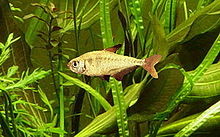
- Gelber von Rio ( Hyphessobrycon bifasciatus ) Ellis, 1911
- Hyphessobrycon isiri Almirón, Casciotta & Koerber, 2006
- Hyphessobrycon igneus Miquelarena, Menni, Lopez & Casciotta, 1980
Hyphessobrycon loweae species group

- Hyphessobrycon elachys Weitzman, 1984
- Kitty tetra ( Hyphessobrycon heliacus ) Moreira, Landim & Costa, 2002
- Hyphessobrycon loweae Costa & Géry, 1994
- Hyphessobrycon moniliger Moreira, Lima & Costa, 2002
- Hyphessobrycon peugeoti Ingenito et al., 2013
- Hyphessobrycon procyon Pastana & Ohara, 2016
Other species currently included in the genus Hyphessobrycon :
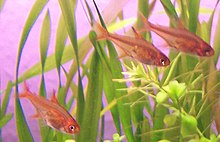


- Hyphessobrycon albolineatum Fernández-Yépez, 1950
- Spark tetra ( Hyphessobrycon amandae ) Géry & Uj, 1987
- Rautenflecksalmler ( Hyphessobrycon anisitsi ) (Eigenmann in Eigenmann & Ogle, 1907)
- Hyphessobrycon arianae Uj & Géry, 1989
- Hyphessobrycon balbus Myers, 1927
- Hyphessobrycon boulengeri (Eigenmann in Eigenmann & Ogle, 1907)
- Hyphessobrycon brumado Zanata & Camelier, 2010
- Hyphessobrycon catableptus (Durbin, 1909)
- Hyphessobrycon chocoensis García-Alzate, Román-Valencia & Taphorn, 2013
- Hyphessobrycon compressus (Meek, 1904) ( type species )
- Hyphessobrycon delimai Teixeira et al., 2016
- Hyphessobrycon diastatos Dagosta et al., 2014
- Hyphessobrycon duragenys Ellis, 1911
- Hyphessobrycon eilyos Lima & Moreira, 2003
- Hyphessobrycon eos Durbin, 1909
- Red from Rio ( Hyphessobrycon flammeus ) Myers, 1924
- Hyphessobrycon frankei Zarske and Géry, 1997
- Hyphessobrycon gracilior Géry, 1964
- Ziegelsalmler ( Hyphessobrycon griemi ) Hoedeman 1957
- Hyphessobrycon hamatus Bertaco & Malabarba, 2005
- Hyphessobrycon hasemani Fowler, 1913
- Hyphessobrycon heteresthes (Ulrey, 1894)
- Hyphessobrycon hexastichos Bertaco & Carvalho, 2005
- Hyphessobrycon hildae Fernández-Yépez, 1950
- Hyphessobrycon iheringi Fowler, 1941
- Hyphessobrycon inconstans (Eigenmann & Ogle, 1907)
- Hyphessobrycon itaparicensis Lima & Costa, 2001
- Hyphessobrycon khardinae Zarske, 2008
- Hyphessobrycon krenakore Teixeira et al., 2016
- Hyphessobrycon langeanii Lima & Moreira, 2003
- Hyphessobrycon latus Fowler, 1941
- Hyphessobrycon maculicauda Ahl, 1936
- Hyphessobrycon melanopleurus Ellis, 1911
- Hyphessobrycon melazonatus Durbin in Eigenmann, 1908
- Hyphessobrycon meridionalis Ringuelet, Miquelarena & Menni, 1978
- Hyphessobrycon minimus Durbin, 1909
- Hyphessobrycon natagaima García-Alzate et al., 2015
- Hyphessobrycon negodagua Lima & Gerhard, 2001
- Hyphessobrycon nicolasi Miquelarena & López, 2010
- Hyphessobrycon ocasoensis García-Alzate & Román-Valencia, 2008
- Hyphessobrycon otrynus Benine & Lopes, 2008
- Hyphessobrycon pando Hein, 2009
- Hyphessobrycon parvellus Ellis, 1911
- Hyphessobrycon piabinhas Fowler, 1941
- Hyphessobrycon pinnistriatus Carvalho et al., 2017
- Hyphessobrycon platyodus Ohara et al., 2017
- Hyphessobrycon proteus Eigenmann, 1913
- Hyphessobrycon pytai Géry & Mahnert, 1993
- Net tetra ( Hyphessobrycon reticulatus ) Ellis, 1911
- Hyphessobrycon robustulus (Cope, 1870)
- Hyphessobrycon rutiliflavidus Carvalho, Langeani, Miyazawa & Troy, 2008
- Small silver tetra ( Hyphessobrycon saizi Géry, 1964 )
- Hyphessobrycon santae (Eigenmann in Eigenmann & Ogle, 1907)
- Hyphessobrycon looking egg Fowler, 1926
- Hyphessobrycon scutulatus Lucena, 2003
- Hyphessobrycon sebastiani García-Alzate, Román-Valencia & Taphorn, 2010
- Hyphessobrycon stramineus Durbin in Eigenmann, 1918
- Hyphessobrycon taguae García-Alzate, Román-Valencia & Taphorn, 2010
- Hyphessobrycon tenuis Géry, 1964
- Hyphessobrycon togoi Miquelarena & López, 2006
- Hyphessobrycon tortuguerae Böhlke, 1958
- Hyphessobrycon tropis Géry, 1963
- Hyphessobrycon tukunai Géry, 1965
- Hyphessobrycon uaiso Carvalho & Langeani, 2013
- Hyphessobrycon veredus Teixeira et al., 2019
- Blueberry Tetra ( Hyphessobrycon wadai Marinho et al., 2016 )
- Hyphessobrycon wajat Almirón & Casciotta, 1999
- Hyphessobrycon weitzmanorum Lima & Moreira, 2003
Aquaristics
Many of the most popular aquarium fish belong to the genus . In fact, most of their representatives can be kept and bred well in captivity, although care should be taken that the animals are sociable and therefore should only be kept in groups of at least ten specimens.
On the other hand, care must be taken to ensure that the limited space available in an aquarium does not result in too many individuals falling below the necessary minimum distance permanently (species-specific overstocking). Many species such as the blood tetra Hyphessobrycon eques then tend to aggression within the species, which can lead to damage battles with not inconsiderable injuries.
swell
literature
- Peter and Martin Hoffmann: Rosy Tetras. In: DATZ the aquarium and terrarium magazine . 6/2004, Verlag Eugen Ulmer , ISSN 1616-3222 .
- Juan Marcos Mirande: Phylogeny of the family Characidae (Teleostei: Characiformes): from characters to taxonomy. In: Neotropical Ichthyology. 8 (3), 2010, pp. 385-568. PDF
- Günther Sterba (Ed.), Gert Brückner: Encyclopedia of Aquaristics and Special Ichthyology. Neumann-Neudamm, Melsungen u. a. 1978, ISBN 3-7888-0252-9 .
- Günther Sterba: The world's freshwater fish. 2nd Edition. Urania-Verlag, Leipzig et al. 1990, ISBN 3-332-00109-4 .
- Dietmar Kunath, Axel Zarske: Hyphessobrycon […]. In: Claus Schaefer, Torsten Schröer (Hrsg.): The large lexicon of aquaristics. Eugen Ulmer, Stuttgart 2004, ISBN 3-8001-7497-9 , pp. 496-506.
Individual evidence
- ↑ Hyphessobrycon on Fishbase.org (English)
- ^ A b Wolfgang Staeck: Tetra from South America. Verlag Dähne 2008, ISBN 978-3-935175-41-8 , pp. 93-94.
- ↑ García-Alzate, Carlos A .; Román-Valencia, César; Ortega, Hernán: Hyphessobrycon taphorni y H. eschwartzae (Teleostei: Characidae) dos nuevas especies de peces de la cuenca del río Madre de Dios, Perú Revista de Biología Tropical, vol. 61, núm. 2, junio, 2013
- ↑ Ota, RR, Carvalho, FR & Pavanelli, CS (2020): Taxonomic review of the Hyphessobrycon panamensis species-group (Characiformes: Characidae). Zootaxa, 4751 (3): 401-436. DOI: 10.11646 / zootaxa.4751.3.1
- ↑ Cristhian C. Conde-Saldaña, Juan G. Albornoz-Garzón, Jorge E. García-Melo, Francisco A. Villa-Navarro, J. Marcos Mirande and Flávio CT Lima. 2019. A New Pristella (Characiformes: Characidae) from the Río Orinoco Basin, Colombia, with A Redefinition of the Genus. Copeia. 107 (3); 439-446. DOI: 10.1643 / CI-18-147
- ↑ a b c Axel Zarske: On the systematics of some blood tetra or "Rosy Tetras" (Teleostei: Ostariophysi: Characidae). In: Vertebrate Zoology. 64 (2), 2014, pp. 139–167.
- ↑ Carlos A García-Alzate, Cesar Román-Valencia, Donald C. Taphorn: Revision of the Hyphessobrycon heterorhabdus -group (Teleostei: Characiformes: Characidae), with description of two new species from Venezuela. Vertebrate Zoology, 58 (2) 2008 139-157 PDF
- ↑ Axel Zarske (2015): Hyphessobrycon clavatus spec. nov. - a new tetra from Peru (Teleostei: Characiformes: Characidae). Vertebrate Zoology, 65 (3): 287-296. PDF
- ↑ Flávio CT Lima, Daniel B. Coutinho, Wolmar B. Wosiacki: A new Hyphessobrycon (Ostariophysi: Characiformes: Characidae) from the middle Amazon basin, Brazil. In: Zootaxa. 3872, 2, pp. 167-179, October 2014 doi : 10.11646 / zootaxa.3872.2.3
- ↑ Priscila Camelier, Fernando Dagosta, Manoela Marinho: New remarkable sexually dimorphic miniature species of Hyphessobrycon (Characiformes: Characidae) from the upper Rio Tapajós basin . In: Journal of Fish Biology . tape 92 , March 1, 2018, doi : 10.1111 / jfb.13579 ( researchgate.net [accessed October 8, 2019]).
- ^ Tiago C. Faria, Flávio CT Lima and Wolmar B. Wosiacki. 2020. A New Hyphessobrycon (Characiformes: Characidae) from the Guiana Shield in Northern Brazil. Copeia. 108 (2); 369-375. DOI: 10.1643 / CI-19-311
- ↑ Terán, GE, Benitez, MF & Mirande, JM (2020): Opening the Trojan horse: phylogeny of Astyanax , two new genera and resurrection of Psalidodon (Teleostei: Characidae). Zoological Journal of the Linnean Society: zlaa019. April 2020. doi: 10.1093 / zoolinnean / zlaa019
- ↑ LFS Ingenito, FCT Lima, PA Buckup: A new species of Hyphessobrycon Durbin (Characiformes: Characidae) from the rio Juruena basin, Central Brazil, with notes on H. loweae Costa & Géry. In: Neotropical Ichthyology. 11 (1), 2013, pp. 33-44.
Web links
- Hyphessobrycon on Fishbase.org (English)



